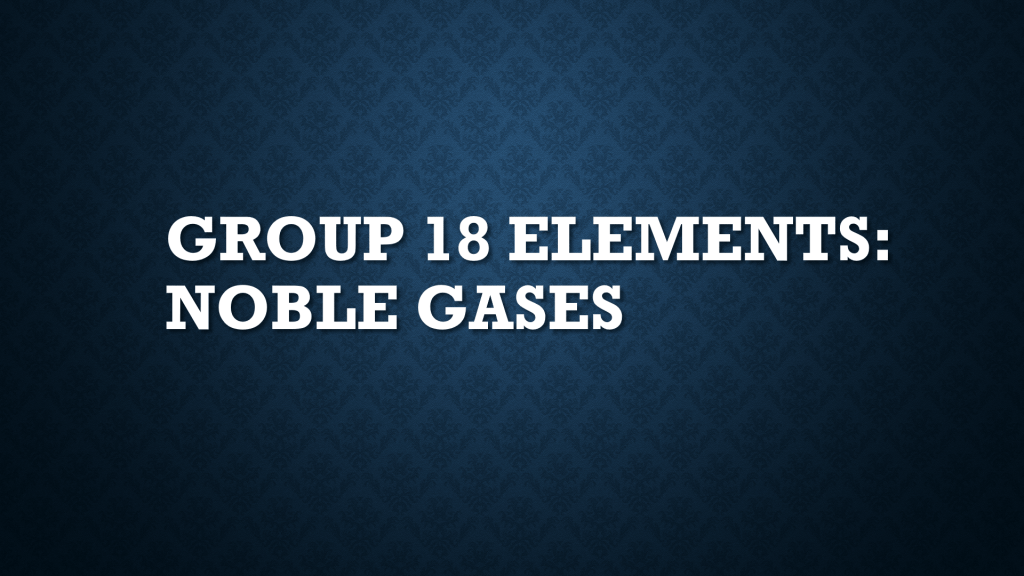Group 18 Elements are also known as Noble Gases or Inert Gases due to their properties of being odorless, colorless, monoatomic and low reactivity. The 7 naturally occurring noble gases are Helium(He), Neon(Ne), Argon(Ar), Krypton(Kr), Xenon(Xe), Radon(Rn), and Oganesson(Og).

Index
History
Helium was discovered by Pierre Janssen and Joseph Norman Lockyer on 18th August 1868 while looking at the chromosphere of the Sun. It was named after the Greek word for the Sun, helios.
Krypton, Neon and Xenon were discovered in 1898 by Scottish scientist William Ramsay, who worked on isolation of helium.
Radon was first identified in 1898 by Friedrich Ernst Dorn and was named radium emanation but was not considered a noble gas until 1904.
In October 2006, scientists from the Joint Institute for Nuclear Research and Lawrence Livermore National Laboratory successfully created synthetically Oganesson by bombarding californium with calcium.
The Group 18 Elements or Noble Gases
The inert gases were traditionally labelled Group 0 because for decades after their discovery it was believed that they could not bond to other atoms, i.e., they could not form chemical compounds. (Though recently Xenon compounds have been formed)
They are located in the p-block, in the periodic table.
| Properties | Helium | Neon | Argon | Krypton | Xenon | Radon | Oganesson |
| Atomic Symbol | He | Ne | Ar | Kr | Xe | Rn | On |
| Atomic Number | 2 | 10 | 18 | 36 | 54 | 86 | 118 |
| Atomic Mass(amu) | 4.00 | 20.18 | 39.95 | 83.80 | 131.29 | 222 | 294 (unconfirmed) |
| Valence Electronic Configuration | 1s2 | [He]2s22p6 | [Ne]3s23p6 | [Ar]4s24p6 | [Kr]5s25p6 | [Xe]6s26p2 | [Rn]5f146d107s27p6 |
| Atomic Radii(pm) | 31 | 38 | 71 | 88 | 108 | 120 | – |
| Melting Point/Boiling Point(K) | -/4.4 | 24.7/27.3 | 83.6/87.4 | 115.8/121.5 | 161.7/166.6 | 202.2/211.5 | 325+/-15/450+/-10 (predicted) |
| Density(g dm3) | 0.1786 | 0.9002 | 1.7818 | 3.708 | 5.851 | 9.97 | 7200 (predicted) |
| First Ionization Energy/kJ mol-1 | 2372 | 2080 | 1520 | 1351 | 1170 | 1037 | 839 (predicted) |
| Common Oxidation State(s) | 0 | 0 | 0 | 0(+2) | 0(+2,+4,+6,+8) | 0,(+2) | -1, 0, +1, +2, +4, +6 (predicted) |
| Electronegativity | – | – | – | 3.00 | 2.60 | 2.20 | – |
Trends in Group 18 Elements
- Electronic Configuration of Group 18 Elements
- Members of group 18 have eight valence electrons, i.e., they have 8 electrons in their outermost orbit(except helium). Thus, they exhibit a stable octet configuration. Helium has a stable duplet configuration.
- Atomic Radii
- The members of group 18 have very small atomic radii. Atomic radii of noble gases increase down the group with an increase in atomic number due to the addition of new shells.
- Ionisation Enthalpy
- Due to having filled outermost orbits, these elements have very high ionisation enthalpies. Ionisation enthalpy value decreases down the group due to increase in size.
- Electron Gain Enthalpy
- Due to filled outermost orbitals, noble gases have high positive electron gain enthalpies.
- Melting and Boiling Points
- The melting and boiling points of noble gases increases down the group due to increase in atomic size.
Applications of Group 18 Elements
- Helium is used as a component of breathing gases, replacing nitrogen.
- Helium is also used in blimps and balloons.
- Neon, in its liquid form, is used in cryogenics.
- It is also used along with other gases and phosphors, in neon lights.
- Argon, when mixed with nitrogen, is used as a filler gas in incandescent light bulbs.
- Argon and helium are both commonly used in metallurgical processes, to shield welding arcs.
- Xenon is used in arc lamps, excimer lasers, medical imaging of lungs through hyperpolarized MRI.
- Xenon is also used in ion engines as inert fuels.
- Radon is used in radiotherapy.
- Oganesson is too unstable to work with and thus no applications for it have been identified yet.
FAQs
As noble gases do not form compounds with other elements, they do not have electronegativity.
During his experiments, William Ramsay kept getting the same proportion of an inert gas left behind. This inert gas did not react with any of the most reactive substances. Hence, he named it Argon from the greek word ‘Argos’ which means lazy or inert.
Helium is the most abundant gas which is followed by Neon and Argon.
Xenon forms maximum number of compounds.
More on P Block
